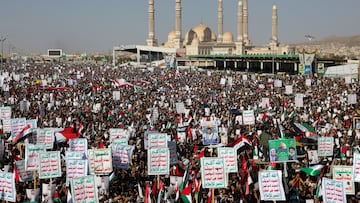Where is Yemen, what is its capital, how many inhabitants does it have and why is it considered bicontinental?
We’ll tell you some facts about Yemen: where is it, its capital, population and why it is in such a strategic location on the Arabian Peninsula.

The Republic of Yemen is a country located in the southwest of the Arabian Peninsula. Its capital is in Sana’a and the nation’s formation is recent, emerging in 1990 as the result of the unification between North Yemen and South Yemen. Currently, it has an estimated population of over 31 million inhabitants according to the Central Intelligence Agency.
The first civil war came in 1994, in a combat between south and north that ended with the victory of the latter. The second great crisis came with the Arab Spring of 2011, which led to the fall of President Ali Abdullah Saleh.
The civil war of 2014, the longest conflict in the country
However, the longest modern conflict in the country is the civil war of 2014, which still continues and pits the Houthis against forces loyal to the Government. The Houthis call themselves Ansarolá or Supporters of God. Originally from Saada, they practice Zaidism, a Shiite branch of Islam close to Sunism, a minority in the country.
They currently control around 30% of the country's territory, including the capital, Sana'a, and other areas near Saudi Arabia. For its part, the official Government, in the hands of Rashad al-Alimi, has its provisional capital in the port city of Aden.
The support of the Houthis and the official government
Saudi Arabia, the United States and other countries in the region support the official Government, while countries like Iran support the Houthis. Other actors that support the group led by Abdul-Malik al-Houth are Hamas and Hezbollah, who are described as the ‘Axis of resistance’.
The Houthis’ continued attacks on ships crossing the Red Sea in response to the conflict in the Gaza Strip have been the trigger for a combined attack by the United States and the United Kingdom on Houthi-controlled sites. This is one of the most important maritime trade routes, especially for the passage of oil and other final consumer goods.
The surface of Yemen and its strategic enclave
The country extends across an area of approximately 205,000 square miles (almost four times the size of Alabama), of which 1,200 miles are of coastline divided between the Red Sea and the Arabian Sea. Yemen borders Saudi Arabia and Oman. All this, added to its presence in the Gulf of Aden, makes this country one of the best positioned at a strategic level, also due to its proximity to the African continent.
In fact, it is one of the few countries in the world considered bicontinental. Its continental part is located in Asia, while the island of Socotra belongs to the African continental shelf.
In addition to this enclave located in the Indian Ocean, its continental territory can be divided into three large areas:
- La Tihama: a coastal strip that extends along the Red Sea.
- The mountains: in the central part of the country that extends from the capital, Sana'a, to Taiz, the altitude does not go below 4,900 feet. Nabi Schuayb Mountain (approx. 12,100 ft) is the highest point in the Arabian Peninsula.
- The northeastern desert: also known as the Empty Quarter, it is a continuation of the southern Saudi desert.
Poverty in Yemen
Yemen’s civil war has plunged the country into what the United Nations has described as “one of the world’s largest humanitarian crises” and is considered one of the poorest countries on the planet. According to the agency, it is estimated that more than 20 million people, or two-thirds of Yemen’s population, “are in urgent need of humanitarian assistance and protection services.”
According to UNHCR data, this war has caused 4.3 million internally displaced people and roughly 80 percent of the population is living below the poverty line.





